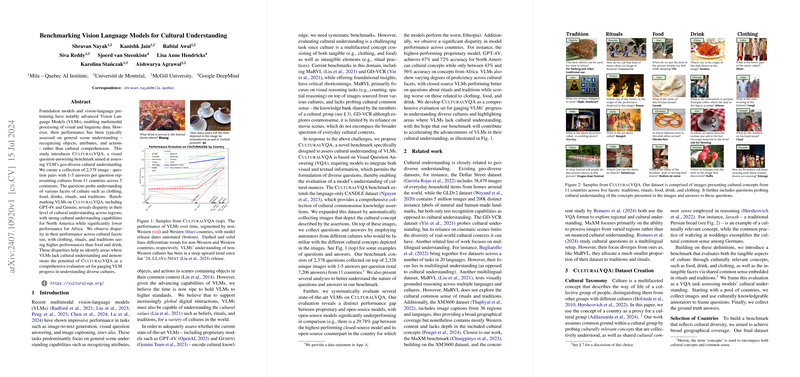Benchmarking Vision LLMs for Cultural Understanding: An Overview
The academic paper titled "Benchmarking Vision LLMs for Cultural Understanding" addresses a crucial yet underexplored area in the advancement of Vision LLMs (VLMs)—their capacity to comprehend cultural contexts. This research introduces CulturalVQA, a novel visual question-answering (VQA) benchmark designed specifically for assessing the cultural understanding of VLMs across a diverse set of geo-cultural landscapes. The paper provides a comprehensive analysis of current VLM capabilities, identifies significant disparities, and lays out the benchmark's potential to guide and improve future developments in this area.
Introduction
The motivation behind the paper stems from the observation that while state-of-the-art VLMs have made significant strides in general scene understanding tasks such as object recognition and action identification, they fall short in the domain of cultural comprehension. Cultural understanding encompasses both tangible elements (e.g., clothing and food) and intangible elements (e.g., rituals and traditions) prevalent within different cultures. This gap in existing VLM capabilities underscores the necessity for benchmarks that evaluate cultural knowledge systematically.
CulturalVQA Dataset
CulturalVQA is distinguished by its global coverage, encompassing cultures from 11 countries across 5 continents, and includes 2,378 image-question pairs with multiple answers per question. The dataset probes various cultural aspects, such as clothing, food, drinks, rituals, and traditions, derived from the Cultural Commonsense Knowledge (CCSK) provided by the CANDLE dataset. CulturalVQA uniquely employs annotators from different cultural backgrounds to ensure the cultural relevancy and accuracy of the questions and answers.
Methodology and Evaluation
The authors employ both closed-source (e.g., GPT-4V, Gemini) and open-source VLMs (e.g., Blip2, InstructBlip, Llava1.5, Llava_Next, Idefics2, Intern-VL 1.5) to benchmark CulturalVQA. The evaluation metric used is LAVE, a reference-based LLM evaluation metric, validated against human judgments.
Key Findings
- Performance Disparity: The results indicate a substantial performance gap between open-source and proprietary models. For instance, the highest-performing open-source model, Intern-VL, trails the best proprietary model by 29.78% in Ethiopia.
- Geographical Performance Variance: The models exhibit a stark variance in performance across different regions. VLMs from North America show higher accuracy (67-72%) compared to African regions (43-56%).
- Facet-specific Performance: On a broader scale, models perform better in understanding cultural facets related to rituals and traditions, with lower efficacy in recognizing food and drink.
- Human vs. Model Performance: Despite the progress, even the best-performing models (e.g., GPT-4V) lag substantially behind human performance, especially in non-Western countries.
Implications and Future Directions
The implications of these findings are twofold:
- Practical Implications: The identified gaps in cultural understanding suggest that VLMs are currently inadequate for applications requiring nuanced cultural context, such as cross-cultural communications or culturally adaptive AI systems. This limitation underscores the need for datasets like CulturalVQA to guide the enhancement of these models.
- Theoretical Implications: The disparities highlight fundamental challenges in the representation of diverse cultural knowledge within multimodal models. The paper suggests that increasing the cultural diversity of training datasets and enhancing model architectures to better capture cultural nuances could be vital steps forward.
Conclusion
The introduction of CulturalVQA marks a significant contribution to the field by providing a structured and systematic benchmark for evaluating and improving the cultural understanding of Vision LLMs. By revealing the current limitations and providing a pathway for future research, the authors of this paper contribute to the broader vision of developing AI systems that are adept at navigating the complexities of global cultural contexts.
Overall, the paper paves the way for more culturally aware AI systems, emphasizing the necessity to bridge the gap between technical capabilities and real-world applications that require a deep understanding of human cultures. Future work should focus on expanding the CulturalVQA dataset to include more countries and cultural concepts, as well as developing multilingual datasets to enrich the cultural competence of VLMs further.
